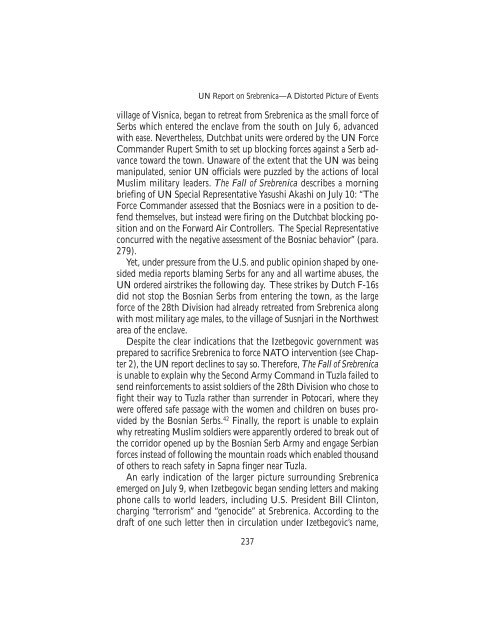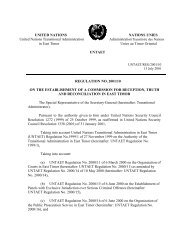The Srebrenica Massacre - Nova Srpska Politicka Misao
The Srebrenica Massacre - Nova Srpska Politicka Misao
The Srebrenica Massacre - Nova Srpska Politicka Misao
You also want an ePaper? Increase the reach of your titles
YUMPU automatically turns print PDFs into web optimized ePapers that Google loves.
UN Report on <strong>Srebrenica</strong>—A Distorted Picture of Events<br />
village of Visnica, began to retreat from <strong>Srebrenica</strong> as the small force of<br />
Serbs which entered the enclave from the south on July 6, advanced<br />
with ease. Nevertheless, Dutchbat units were ordered by the UN Force<br />
Commander Rupert Smith to set up blocking forces against a Serb advance<br />
toward the town. Unaware of the extent that the UN was being<br />
manipulated, senior UN officials were puzzled by the actions of local<br />
Muslim military leaders. <strong>The</strong> Fall of <strong>Srebrenica</strong> describes a morning<br />
briefing of UN Special Representative Yasushi Akashi on July 10: “<strong>The</strong><br />
Force Commander assessed that the Bosniacs were in a position to defend<br />
themselves, but instead were firing on the Dutchbat blocking position<br />
and on the Forward Air Controllers. <strong>The</strong> Special Representative<br />
concurred with the negative assessment of the Bosniac behavior” (para.<br />
279).<br />
Yet, under pressure from the U.S. and public opinion shaped by onesided<br />
media reports blaming Serbs for any and all wartime abuses, the<br />
UN ordered airstrikes the following day. <strong>The</strong>se strikes by Dutch F-16s<br />
did not stop the Bosnian Serbs from entering the town, as the large<br />
force of the 28th Division had already retreated from <strong>Srebrenica</strong> along<br />
with most military age males, to the village of Susnjari in the Northwest<br />
area of the enclave.<br />
Despite the clear indications that the Izetbegovic government was<br />
prepared to sacrifice <strong>Srebrenica</strong> to force NATO intervention (see Chapter<br />
2), the UN report declines to say so. <strong>The</strong>refore, <strong>The</strong> Fall of <strong>Srebrenica</strong><br />
is unable to explain why the Second Army Command in Tuzla failed to<br />
send reinforcements to assist soldiers of the 28th Division who chose to<br />
fight their way to Tuzla rather than surrender in Potocari, where they<br />
were offered safe passage with the women and children on buses provided<br />
by the Bosnian Serbs. 42 Finally, the report is unable to explain<br />
why retreating Muslim soldiers were apparently ordered to break out of<br />
the corridor opened up by the Bosnian Serb Army and engage Serbian<br />
forces instead of following the mountain roads which enabled thousand<br />
of others to reach safety in Sapna finger near Tuzla.<br />
An early indication of the larger picture surrounding <strong>Srebrenica</strong><br />
emerged on July 9, when Izetbegovic began sending letters and making<br />
phone calls to world leaders, including U.S. President Bill Clinton,<br />
charging “terrorism” and “genocide” at <strong>Srebrenica</strong>. According to the<br />
draft of one such letter then in circulation under Izetbegovic’s name,<br />
237



